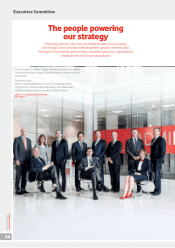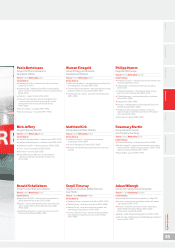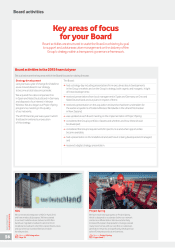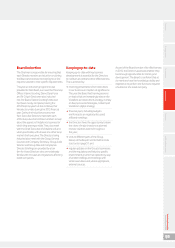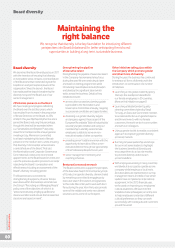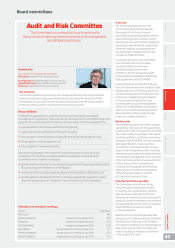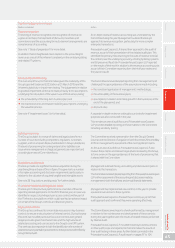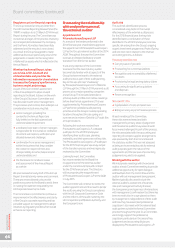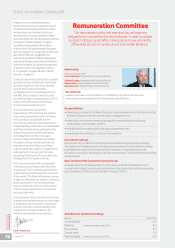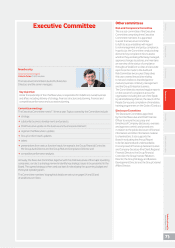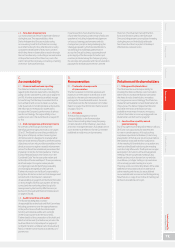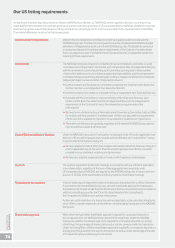Vodafone 2015 Annual Report Download - page 66
Download and view the complete annual report
Please find page 66 of the 2015 Vodafone annual report below. You can navigate through the pages in the report by either clicking on the pages listed below, or by using the keyword search tool below to find specific information within the annual report.
Board committees (continued)
In addition to more recurring activities driven
by the Group’s external nancial reporting
calendar and related regulatory obligations,
the Committee conducts a rolling programme
of “in-depth review” sessions where the
Group’s senior management provide briengs
on key issues and developments including
in relation to aspects of risk management.
These reviews help us to understand more
fully the context and challenges of their
business operations and thereby ensure the
Committee’s time is used most effectively.
A summary of the reviews undertaken during
the year are set out within “Monitoring the
Group’s risk management system and its
effectiveness” below.
The external auditor, PricewaterhouseCoopers
LLP, is invited to each meeting together with
the Chief Executive, the Chief Financial Ofcer,
the Group Financial Controller, the Group
Financial Reporting Director, the Group Audit
Director, the Group Risk and Compliance
Director, and the Group General Counsel
and Company Secretary. The Committee
also regularly meets separately with
PricewaterhouseCoopers LLP, the Chief
Financial Ofcer and the Group Audit Director
without others being present.
We believe that the activities of the
Committee during the last year have enabled
us to gain a good understanding of the culture
of the organisation, the risks and challenges
faced and the adequacy and timeliness
of the actions being taken to address them.
Similar to last year, I, together with the
Committee’s secretary, conducted an internal
review of effectiveness of the Committee
involving the members of the Committee,
the Group’s senior management and the
external auditor. This conrmed that the
Committee remained effective at meeting
its objectives.
Main activities of the
Committee during the year
I have set out below a summary of the major
activities of the Committee in the year.
Appropriateness of Group’s external
nancial reporting
The Committee’s primary responsibility
in relation to the Group’s nancial reporting
is to review with both management and the
external auditor the appropriateness of the
half-year and annual nancial statements
concentrating on, amongst other matters:
a the quality and acceptability of accounting
policies and practices;
a material areas in which signicant
judgements have been applied or where
signicant issues have been discussed with
the external auditor;
a the clarity of the disclosures and
compliance with nancial reporting
standards and relevant nancial and
governance reporting requirements;
a any correspondence from regulators
in relation to our nancial reporting; and
a whether the Annual Report, taken
as a whole, is fair, balanced and
understandable and provides the
information necessary for shareholders
to assess the Company’s performance,
business model and strategy.
Accounting policies and practices
The Committee received reporting from
management in relation to the identication
of signicant accounting policies including
the proposed disclosure of these in the 2015
Annual Report. Following this assessment and
discussions with PricewaterhouseCoopers
LLP the Committee was satised with these
judgements and related disclosure which is set
out on pages 109 to 113 of this Annual Report.
We have included detail in relation to IFRS 15
“Revenue from contracts with customers”
which is likely to have a very substantial effect
on the Group’s accounting when it is adopted,
which is now likely to be in the 2019
nancial year.
Further, the Committee discussed with
management and subsequently approved
the critical accounting judgements and key
sources of estimation uncertainty outlined
in note 1 “Basis of preparation” to the
consolidated nancial statements.
Signicant judgements and issues
The signicant areas of focus considered
by the Committee in relation to the 2015
accounts, and how these were addressed,
are outlined below. We have discussed these
with the external auditor during the year and,
where appropriate, how these have been
addressed by areas of audit focus as described
in the Audit Report on pages 97 to 104.
Signicant judgements and issues
Matter considered Action
Taxation
The Group is subject to a range of tax claims and related legal
actions across a number of jurisdictions where it operates. The most
material claim continues to be from the Indian tax authorities in
relation to our acquisition of Vodafone India Limited from Hutchison
Telecommunications International Limited group in 2007.
Further details of this claim are described in note 30 “Contingent
liabilities”.
Further, the Group has extensive accumulated tax losses as outlined
in note 6 “Taxation”, and a key management judgement is whether a
deferred tax asset should be recognised in respect of these losses. As
at 31 March 2015, the Group had recognised a £23.8 billion deferred
tax asset primarily in respect of these tax losses.
The Group Tax Director presented on both provisioning and disclosure
of tax contingencies and deferred tax asset recognition at the
November 2014 and May 2015 Committee meetings.
He also outlined management’s view and response to the changing
political and public attitude to tax and in particular the OECD’s action
plan to deal with base erosion and prot shifting.
In respect of tax contingencies, the challenge from the Committee
focused on the extent and strength of professional advice received
from external legal and advisory rms.
In relation to the public and political environment, the Committee
required management to manage taxes transparently and with due
regard to commercial and reputational risks.
In relation to the recognition of the deferred tax assets, the Committee
challenged management’s expectations for future taxable prots.
The statutory auditor also identied this as an area of higher audit risk
and the Committee received reporting from them on these matters.
The Group’s disclosure in relation to the judgements underlying the
recognition of the Group’s signicant deferred tax assets and related
sensitivity of these asset values to changes of assumptions was
enhanced in the 2015 Annual Report.
Vodafone Group Plc
Annual Report 2015
64


